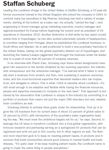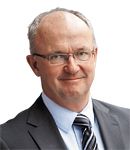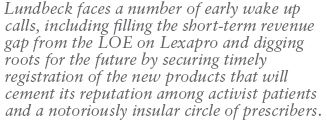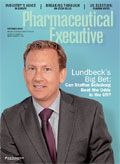Lundbeck: Bidding for the Stars and Stripes
Pharm Exec takes a look at how a mid tier player - Denmark's Lundbeck - is counting on the momentum of the big US market to vault it to global leadership position.
As the blockbuster sales model fades, the rush is on for a new formula for growth. "Good" growth: niched, balanced, and sustainable; with high margins from protected pricing; more patient-friendly than patent-centric; and where revenues draw from a deep reservoir of unmet medical need. The sized up, process-driven culture of Big Pharma is finding that new formula hard to swallow: it's a select menu of lean cuisine, without the familiar protein of mass promotion. In fact, the truest advocates of the new "good" growth come from unexpected quarters—what we at Pharm Exec call the "stealth" companies, those second tier players who aspire to reach the top by achieving a dominant market position around targeted drugs for underserved conditions. In the following profile, Pharm Exec takes a closer look at how one key mid-tier player—Denmark's H. Lundbeck—is counting on the momentum of the big US market to vault it to global leadership in treatments that unlock the hard science of the human brain.
Understatement is core to the Nordic psyche, which raises an interesting question: In a business driven by a complex mix of hope and hype, is it Lundbeck's misfortune to be Danish? "A company of quiet accounts" is how one analyst describes Lundbeck's trajectory since its founding in 1915 by a Danish trading executive, Hans Lundbeck, whose mission was to keep the neutral Danes well supplied with everything from butter to cosmetics during the Great War and beyond. Some early marketing of painkillers led to a post-1945 commitment to the still nascent field of psycho-pharmaceuticals, which culminated in 1959 with the launch of Truxal, the first recognized treatment for schizophrenia and a world-class brand that expanded the company presence beyond Denmark.

From left to right: Anders Buur, VP, US drug development; Sally Benjamin Young, VP, US public affairs; Peter Anastasiou, VP and general manager, US Psychiatry; Dan Brennan, VP and general manager, Neurology; Joe Nolan, chief commercial officer; and Staffan Schuberg, president US.
Still, relatively little is known in the United States about Lundbeck's subsequent emergence as a company uniquely dedicated to the discovery and development of medicines for CNS disorders. For example, despite its diminutive size compared to Lilly and Pfizer in the high-growth category of anti-depressants, Lundbeck's labs have regularly spawned drugs that provide a forward step in therapy through new modes of action, providing clinicians and patients with more choice. Lundbeck scientists synthesized and introduced one of the first trycyclic anti-depressants and its early investigations on the SSRI class pre-dated the Big Pharma competition. The company's biggest seller, an SSRI with the proprietary name Cipralex, helped transform the company from a European to a truly multinational enterprise after it was introduced in 2002.
Lead in for Lexapro
Perhaps the biggest surprise about Lundbeck is that Cipralex is marketed in the United States as Lexapro; rights holder Forest Labs leveraged the drug's well-tolerated, low side-effects profile to create an iconic blockbuster that held a 25 percent share of the anti-depressant market until its US patent expired in March. Lexapro, as well as another predecessor drug from Lundbeck, Celexa, helped Forest expand beyond its generic roots and establish itself as a household name in the US mental health practice community, while Lundbeck remained a bit of a cipher to the same.
Lundbeck's low profile has been accentuated by its distinct ownership model. The company's shares have been listed publicly only since 1999. And similar to its larger Danish counterpart, Novo Nordisk, some 70 percent of the company's shares are held by a foundation established in 1954 by the widow of founder Hans Lundbeck. Besides safeguarding the company's financial health, the Foundation has a mission to promote basic research geared to fighting neglected diseases, especially mental illness and related disorders of the brain. It donated $89 million to this end in 2011, above and beyond the average 20 percent of revenues (a ratio that is one of the highest in the industry) the company itself spends on R&D each year. Lundbeck CEO Ulf Wiinberg told Pharm Exec that while being publicly listed makes management accountable, the foundation's dominant share position gives executives more freedom to fly below the radar and focus on the longer term. "Without the foundation, we'd likely have been acquired years ago," he said.
Partnering around the brain
Although Lundbeck's name recognition might score low among the general public, especially outside Europe, reputation in this industry is built patient by patient: the deeper the roots you have in a community of the sick, the better the financial—and societal—return. Lundbeck applies this philosophy in two ways. First, by creating a company culture centered on partnership; not just with other institutions but also affecting how work is done internally. Second, through a highly specialized business strategy geared to the discovery, development, and commercialization of drugs for the treatment of CNS diseases.
Melding the two is an overriding emphasis on the patient, not just as a marketing target but as a source of the science insight that drives clinical development. "Partnership is central to our DNA—between our research, clinical development and commercial teams—so it has been easy to extend this culture to the way we approach patients," says Lundbeck USA President Staffan Schuberg. "We have 60 years of experience in working with the CNS and mental health communities. That intimacy with the patient extends to our business partners; they know we are deeply committed to neurologic and psychiatric disorders and we aren't going to surprise them with a sudden change in direction that undermines the relationship."

We have 60 years of experience in working with the CNS and mental health communities. That intimacy with the patient extends to our business partners; they know we are deeply committed to neurologic and psychiatric disorders and we aren't going to surprise them with a sudden change in direction that undermines the relationship. -Staffan Schuberg
For a small company, an internal culture built around patients and partnerships can be a source of leverage against competitors with a greater scale and geographic presence. This is especially evident in the United States, where the activism of patient groups has fostered networks with prescribing clinicians that would be difficult or very costly for any drug company to replicate on its own. For Lundbeck, insights from this patient journey of self-discovery has led to greater understanding of the therapeutic impact of CNS disorders, affecting the design of trials, lowering the cost of trial recruitment, and—hopefully—boosting relations with the disease community once its medicines are approved.

Staffan Schuberg
Lundbeck's culture of inclusion begins with recruitment. Says Dan Brennan, VP and general manager for neurology, "the selection process in our US sales force starts with a fundamental question: Is the candidate more about 'we' or 'me?' Most of the reps in Big Pharma come from a culture that touts individual advancement—being first—and unfortunately this perspective has been enhanced by all the downsizing. With such a big applicant pool, we have the ability to screen for specific personality types, who want to make that extra connection to patients and the disease through a cultural sensitivity on what it takes to be a good partner."
Hard science
However, the therapeutic focus on the brain and its disorders carries some risk. While there is high market opportunity because of the enormous unmet medical need, that need exists because the science behind the cure is so elusive. According to the World Health Organization (WHO), one out of every four people develops a mental illness at some point in their lives; the number of patients with dementia is forecast to double—to more than 75 million—over the next 18 years. In China alone, CNS-related conditions are now the fastest growing source of healthcare expenditures; worldwide, the indirect economic burden of caring for mentally disabled people is rising even faster than their prevalence.
At the same time, new drug treatments for this population have been slow to emerge from the laboratory. The Tufts Center for the Study of Drug Development (TCSDD) finds that neuroscience drug candidates carry the longest lead time from proof of concept to registration (10 years plus) of any therapeutic sector—a key indicator of risk for a process where time is money. Because of the size and complexity of clinical trials in the CNS field, many candidates end up failing at the crucial Phase III stage of development, where costs tend to be highest. Over the past decade, big companies like Pfizer have scaled down or abandoned their commitment to the field, resulting in less competition and more "blue ocean" market space for those who opt to stay the course.
Lundbeck is diluting some of the financial risks in CNS through close, selective partnerships. In September 2007, the company forged a link with Japan's Takeda on a long-term arrangement to evaluate and commercialize treatments for mood and anxiety disorders. Last November, it inked an even bigger deal with another Japanese drug maker, Otsuka, to develop and market medicines in the psychiatry field, building on that company's US anti-psychotic blockbuster, Abilify. One key driver of the deal is the sharing of development and marketing costs.
In addition to the scientific challenge of brain disorders, the Lundbeck product portfolio is in a transitional phase. The company's top-selling therapy, the anti-depressant Cipralex/Lexapro, which accounted for well over half of Lundbeck's worldwide sales of $2.9 billion in 2011, faces a loss of exclusivity in most marketed countries over the next 12 months. The crucial US patent on Lexapro expired in March, and sales here have since dropped by more than two thirds. In Europe, the drug is already subject to intense generic competition. The only bright spot for the once blockbuster drug is Japan, which saw launch of Lexapro last August and with support from partners Mochida and Mitsubishi Tanabe has already wrested a respectable 3.5 percent market share.
Lundbeck's other key products—Ebixa, (promoted by Forest as Namenda in the United States) a treatment to slow cognitive decline in Alzheimer patients; Azilect, (promoted by Teva in the United States) for Parkinsons Disease; Xenazine, an orphan drug used to treat chorea associated with Huntington's disease; and Onfi, an anti-epileptic—are targeted specialty products; together, they are unlikely to achieve the blinding success of the Cipralex/Lexapro franchise. Finally, another new product launched within the past year, Syncrest, an anti-psychotic for bipolar disease and schizophrenia developed by Merck, which Lundbeck is marketing in Europe, is building slowly and will take time to create a significant revenue base.
It's show me time
The pregnant question of the moment is: What's next? CEO Wiinberg calls the erosion of the big anti-depressant franchise around Cipralex/Lexapro a natural development in the product cycle, one that management has been anticipating for some time. Vortioxetene, a potentially winning replacement for Cipralex/Lexapro, is poised and ready for regulatory approval in key markets. Last month, the company filed an application with the European Medicines Agency, noting that vortioxetene is the first filing of a novel anti-depressant in Europe since 2007. Overall, the company claims a fairly full pipeline, enough for Wiinberg to make the pledge to analysts that by 2015 one half of worldwide revenues will come from new products—in other words, filling the gap left by the fading market leader.
In presentations to analysts, management touts three drugs that, in addition to vortioxetene, it sees as real breakthroughs: Selincro, designed to treat alcohol dependence and destined to be marketed in Europe; Treanda, in-licensed from Cephalon/Teva for treatment of chronic lymphocytic leukemia, to be marketed only in Latin America and Canada; and aripiprazole depot, a once-monthly injectible version of the Otsuka drug Abilify, to treat schizophrenia. Together, and assuming appropriate regulatory approvals over the next 18 months, the drugs carry a potential revenue stream of nearly $2 billion, or more than enough to replenish the base lost to generic competition. There is also a diamond in the rough: AE58054, a drug candidate specifically aimed at cognition repair among Alzheimers patients, has completed Phase II trials and could advance the state of care by slowing basic skills deterioration. Lundbeck is considering partners to move this compound forward.
America calls
What analysts refer to as a "promising" pipeline is in some ways the surround sound for a much bigger agenda. As the Japanese industry well knows, good science and promising drugs do not by themselves spin profits. Resources, expertise and geographical reach are necessary to avoid having to share the bounty with others that already possess the scale to compete. The implicit desire of any middle-size company is to grow enough to partner on the basis of choice, not necessity. To shed the burden of dependence and— literally—have it all.
In deciding to move up, Lundbeck is moving in—on the big prize, the tough US market. As the industry becomes more global, it is apparent that no enterprise with aspirations to be global can succeed without carving out a strong presence here in the United States. The intense competition in the home base of the industry's biggest companies acts as a training ground for operational excellence; you learn from a process of Darwinian selection that separates the strong from the weak. CEO Wiinberg notes that the real value of being in the US market is the breadth and richness of the contacts. "It's hard to compete for a global asset if you have no presence to tap the innovations that come from all the scientists, thought leaders, entrepreneurs, and dealmakers who make their home there."
Peter Anastasiou, Lundbeck USA's vice president and general manager for psychiatry, states it simply to Pharm Exec. "The destination for future growth in most other pharma companies is China, India—the emerging country markets. Our emerging market is the United States." And there are two therapeutic platforms where Lundbeck USA is vying for market leadership: specialty neurology products, with an adapted portfolio of difficult-to-treat epilepsy products as well as for rare hereditary conditions like Huntington's disease; and psychiatry practice medicines, including novel next generation anti-depressants and anti-psychotics for schizophrenia.
A running start with Ovation
Lundbeck began filling its play card for America three years ago, when it acquired Ovation Pharmaceuticals, a privately held Illinois-based specialty drug firm that matched Lundbeck's therapeutic focus on brain disorders and had deep roots in the rare disease community. The billion dollar transaction gave Lundbeck what it needed: a bolt-on commercial sales platform in key target therapies as well as strong networks from which to build partnerships among local constituencies that count: researchers, physicians, payers, and patients. Lundbeck inherited a highly-trained sales force with expertise in managing relationships with the select group of US specialist physicians who do the bulk of prescribing for rare conditions like Huntington's disease, a neurodegenerative disorder for which there is no cure. There were also some good partnerships to continue in place, including one with Biovail (now part of Canadian-based Valeant), for the marketing of Xenazine.
Built on a start-up mentality, Ovation was filled with many exiles from Big Pharma looking to run a different kind of organization. So there was some question of how all this would mesh with Lundbeck's dour Nordic profile. Says USA President Schuberg, who helped push the acquisition forward, "we knew from our partnership record that the number one reason a deal fails is not being sensitive to culture issues. Looking back, I can say we did one prescient thing and that was not dumping all our manuals and rule books, and instructing our new colleagues to read them and come back on Monday as a Lundbeck employee. Instead, we took our time, got engaged and posed a lot of questions, stating 'here's how we view things, what's your take?' We melded their thoughts with our own and ended up being stronger for it."
Another positive was that Lundbeck itself was on a learning curve, having never run a US business before. "The truth is there was no rule book," notes US chief commercial officer Joe Nolan. "The two organizations had a lot to learn from each other. It became evident that there was little merit in dispensing with the commercial platforms that had attracted us to them in the first place." For example, Ovation's strategy of building sales through mutually beneficial alliances with patient groups was an excellent tutorial on how to be successful in the sharp-elbowed US market.
A networked business model
It's a lesson that the new US business has taken to heart. Anders Buur, VP of US drug development, told Pharm Exec "the accessibility of patients and their organized influence on the medical profession's understanding of disease is unique to the United States. The ability to team with patient and professional groups in clinical development is a key reason why we are here—and our definition of a good partner extends beyond the scope of any commercial alliance."

Lundbeck Partnering Institutions in the US
In 2010 Lundbeck USA launched the Huntington's Disease Research Initiative to seed networks among academic research organizations and the private sector and underwrite new therapeutic approaches to this rare condition. One of the more interesting compacts under this program was signed in May with the CHDI Foundation, a non-profit dedicated to funding collaborative research in this area. Specifically, CHDI will conduct pre-clinical studies on an investigative compound owned by Lundbeck that might represent a new pathway for attacking the disease and alleviating its symptoms. Simon Noble, CHDI's director of scientific communications, told Pharm Exec that the new arrangement with Lundbeck was an easy sell, given the ties that the company had already built among a very committed and passionate base of patients and caregivers.
New approach to R&D
The enormous science base in the United States is clearly an asset that Lundbeck intends to exploit. Management considers that establishing an R&D presence here is equally, if not more, important than laying down commercial roots. In fact, the big leap into the United States helped drive the company decision to revise its entire research strategy. Instead of the previous emphasis on building a research portfolio around four disease indications, it adopted a broader approach geared to uncovering the disease biology that underlies the CNS segment as a whole. This will give Lundbeck researchers and partners more focus in seeking out compounds that, if successful, would be real game changers and find ready acceptance in clinical practice. Says Anders Buur, "success rates in CNS are too low. The aim of this reorganization is to improve on that and generate better hits beyond the current standard of care. If we are to confront the human pathology of CNS disease with targeted medicines, we must understand the biology that creates these disorders in the first place."
Work is now allocated within three disease biology units—covering neuro-inflammation; neuro-degeneration; and synaptic transmission—and conducted at research centers in Copenhagen and Paramus, NJ. A third R&D center, in Shanghai, China, plays an integrating role with a focus on medical chemistry. The Paramus unit, which grew out of a research enterprise purchased by Lundbeck in 2003, is responsible for directing R&D on neuro-inflammation; Copenhagen coordinates the other two. Overall, however, the US group is vital to the new R&D structure because what the company needs—expertise in the basic biologics of CNS disorders—is found mainly in the large academic teaching institutions based in the United States. "Much of our scientific collaboration and partnering work is now occurring here and will filter through the entire global enterprise," says Buur (see list above).
Filling the specialty gap
Lundbeck is choosing its US growth targets carefully, with an emphasis on specialty niches in neurology and psychiatry while relying on its marketing partners—including Takeda and Otsuka—to cover high-cost forays into the primary care space, where big sales forces are a prerequisite for doing business. Since the Ovation takeover, Lundbeck has doubled the size of its neurology sales force and is recruiting highly experienced detailers who know the disease profiles enough to build long-lasting relationships with key prescriber physicians. "We want community builders—experienced sales professionals with the technical knowledge to liaise with specialist physicians, but who are also able to bring awareness of CNS diseases forward to the patient organizations and care givers," said Dan Brennan.

It’s hard to compete for a global asset if you have no presence to tap the innovations that come from all the scientists, thought leaders, entrepreneurs, and dealmakers who make their home in the United States. - Ulf Wiinberg
At the same time, Lundbeck is creating a psychiatry sales force from scratch to prepare for a number of important product launches in the next 18 months. The centerpiece is vortioxetene, the highly-touted successor to Lexapro, with a new mode of action that will give clinicians additional options in treating patients who have cycled through existing treatment options such as SSRIs. The compound is part of the alliance with Takeda, which, if the drug is approved, will assume the major role in marketing and promoting it among GPs. Lundbeck will focus on specialist prescribing. And the point man for this effort is VP for US psychiatry Peter Anastasiou. "We're creating that sales force as we speak. All of our recruits must have demonstrated prior success in CNS. More important, we are pursuing a much more interactive, relationship-driven, needs-oriented and highly specialized sales model where we provide solutions to help our customers. It's not going to be a role that involves just showing up to deliver three message points and some literature."
Vortioxetene has completed Phase III testing and the companies hope to file an NDA with the FDA before the end of this year. Other targets being pursued for the US market include the aripiprazone depot formulation, which is being developed jointly with Otsuka and is now awaiting final FDA action pending resolution of some manufacturing challenges with a third party supplier of sterile water identified by the agency. Two additional prospects are desmoteplase, a compound designed to significantly extend the time window for remedial treatment of stroke; and LUAE58054, the Alzheimers cognition treatment that the company is considering for possible partnership support.
Prising out pitfalls
Creating a viable, permanent business in the world's most competitive market is no simple task—and, as the experience of other foreign newcomers has shown, success in the United States is never earned overnight. In fact, Lundbeck faces a number of early wake up calls, including filling the short-term revenue gap from the LOE on Lexapro and digging roots for the future by securing timely registration of the new products that will cement its reputation among activist patients and a notoriously insular circle of prescribers. Both tasks depend heavily on forging new relationships and elbowing into turf that Big Pharma rivals have been cultivating for decades.

The US promotional environment is also changing at warp speed. Tactics used to woo customers in the past—such as the sponsorship of professional medical conferences, which are particularly important in the complex CNS space—are now either discouraged or illegal. "Creating a product message that resonates is more challenging than ever because there is so much new regulation coupled with endless 'white noise' competition," observes Pharm Exec advisory board member Al Topin, who leads his own marketing agency. "Resources are important. New, mid-sized contenders like Lundbeck must work that much harder to differentiate themselves from all the alternatives available to payers and patients."
Further on that score, the company had to overcome a potentially damaging reputational hit linked to a Federal Trade Commission claim of anti-competitive pricing on products acquired through the purchase of Ovation – a case Lundbeck won in district court and on appeal.
Yet in a bigger world that astounds with complexity, there is much virtue in simplicity. According to CEO Wiinberg, Lundbeck will prevail because its mission is simple, with all assets pointed in one direction. "We began as a European company; have become an international company; and now aim to be global, with a permanent presence in the United States and diseases of the brain as our focus." Watch and wait—the Danes are here.

The Misinformation Maze: Navigating Public Health in the Digital Age
March 11th 2025Jennifer Butler, chief commercial officer of Pleio, discusses misinformation's threat to public health, where patients are turning for trustworthy health information, the industry's pivot to peer-to-patient strategies to educate patients, and more.
Navigating Distrust: Pharma in the Age of Social Media
February 18th 2025Ian Baer, Founder and CEO of Sooth, discusses how the growing distrust in social media will impact industry marketing strategies and the relationships between pharmaceutical companies and the patients they aim to serve. He also explains dark social, how to combat misinformation, closing the trust gap, and more.
Applying Porter’s Five Forces to Portfolio Management in Pharmaceutical R&D: A Strategic Roadmap
March 17th 2025The increasing costs and complexity of R&D in the pharmaceutical industry have necessitated the adoption of strategic portfolio management to optimize resource allocation and enhance competitive advantage.